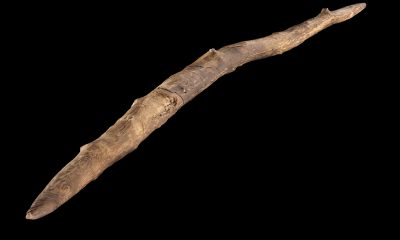Great white sharks form friendships as they prowl the oceans
Their mysterious social lives were revealed for the first time after they were tracked off the coast of Mexico.
Published
2 years ago onBy
Talker News
By Mark Waghorn via SWNS
In popular culture, they are depicted as lone predators appearing out of nowhere to attack but Great white sharks form friendships as they prowl the oceans, according to new research.
The killing machines have personalities - and a softer side. Some are gregarious and others shy - just like us.
Their mysterious social lives were revealed for the first time after they were tracked off the coast of Mexico.
Gathering seasonally around Guadalupe Island, they found the sharks tended to stick together when patrolling.
For instance, they stopped by to check out the seal colonies - like going on a shopping trip with mates. Some were together for over an hour.
Lead author Dr. Yannis Papastamatiou, of Florida International University (FIU), explained: "Most associations were short.
"But there were sharks where we found considerably longer associations, much more likely to be social associations.
"Seventy minutes is a long time to be swimming around with another white shark."
They can reach 22 feet long and weigh more than 2.5 tons - with orcas their only rival in the food chain.
A perfectly streamlined torpedo-shaped body and powerful tail propels them through the water at up to 15 miles an hour.
Dr. Papastamatiou said: "Understanding the social dynamics of large marine predators in the wild is challenging.
"We put tags on white sharks of off of Mexico that measured behavior and time spent with other tagged sharks.
"We showed sharks may form some strong associations - over a few days - with some individuals.
"But there is a lot of variation between sharks in terms of how social they may be and how they behave.
"Sharks may stay in proximity of other individuals in case those individuals are successful in killing large prey.
"Biologging can start to reveal the secrets of the social lives of large sharks."
Six great whites were followed - three males and three females - over a four year period.
The data showed for the most part, they prefer to be in groups with members from their same sex.
If the sharks shared any other similarities, it was in how totally unique each one was.
One that kept its tag on for only 30 hours had among the highest number of associations - 12 sharks.
Another had the tag on for five days - and only spent time with two other sharks. They also displayed different hunting tactics.
Some were active in shallow waters, others deeper down in the depths. Some were more active during the day, others at night.
The challenge of the hunt was reflected in the video footage, analysed by FIU undergraduate Seiko Hosoki.
A great white followed a turtle. Then, the turtle saw it and got away. A great white followed a sealion.
Then, the sealion spotted it, danced loops around the shark and got away.
Dr. Papastamatiou said: "This isn't unique to white sharks, since predators are unsuccessful a lot of the time when hunting."
That is why forming social associations might be so important. He has studied the social lives of other shark species.
Sociality increases the ability to take advantage of another shark's hunting success. The same may be happening at Guadalupe.
Dr. Papastamatiou said: "The important question we still have to answer is what is the reason for being social for these sharks?
"We still don't know. But it is likely they may stay in proximity of other individuals in case those individuals are successful in killing large prey.
"They aren't working together but being social could be a way to share information."
Guadalupe is brimming with tuna and seals - making it a hotspot for great whites.
The blue and clear waters are different from murkier hang outs around South Africa or Australia where they launch sneaky ambushes.
Prey and predators can easily see each other - making it an ideal location for the groundbreaking investigation.
Dr. Papastamatiou said: "Normally, studying such cryptic animals usually involves some form of tracker. We knew we were going to need a much bigger, better tag."
Stealing a line from Jaws, one of the team quipped :"Your'e gonna need a bigger tag."
So they combined different commercially available technology into a 'super social tag'.
It collected data for up to five days before popping off the shark's dorsal fin - and floating to the surface.
The device was equipped with a video camera and an array of sensors that recorded a host of movements.
They included changes in acceleration, depth, direction - and even how rapidly the shark turned while swimming.
Dr. Papastamatiou said: "What put the 'social' in this specific tag was special receivers that could detect other tagged sharks nearby."
They had previously been tracked over the years by co author Dr. Mauricio Hoyos-Padilla from Fins Attached Marine Research and Conservation in Colorado Springs.
Around three dozen of these showed up on another great white's super social tag.
The study in the journal Biology Letters adds to evidence great whites form non-random friendships.
It also sheds light on when they happen. He hopes to one day use these special tags to track sharks over longer periods, like weeks or even years.
Added Dr. Papastamatiou: "Technology now can really open up the secret lives of these animals.
"We are going beyond tracking where they are and where they go. As the technology gets better, we can keep answering more questions."
It could help save the great white from species. It is endangered - along with most other species of shark.
Great whites are rare due to years of being hunted by man for fins and teeth, and often as a trophy for sport fishing.
They are often caught as bycatch by commercial fisheries and can also become entangled in meshes that protect beaches.
Stories and infographics by ‘Talker Research’ are available to download & ready to use. Stories and videos by ‘Talker News’ are managed by SWNS. To license content for editorial or commercial use and to see the full scope of SWNS content, please email [email protected] or submit an inquiry via our contact form.
You may like


Metals can heal themselves just like ‘The Terminator’


Two-faced star has hydrogen on one side and helium on other


World’s oldest big game hunting weapon found


An espresso a day could keep Alzheimer’s at bay


Being bipolar significantly raises risk of premature death: study


Soccer players who regularly use head more likely to develop Alzheimer’s
Other Stories


New breakthrough treatment boosts cancer-fighting cells
The approach involves activating the immune cells in the body and "reprogramming" them to attack and destroy the cancer cells.


One-year-old can’t stop laughing during first ride at Disneyland
"We didn't expect him to love it that much."


Dad running marathon wearing chainmail weighing over 40 pounds
A dad is attempting to break the world record for the fastest marathon while wearing chainmail.


Hero saves elderly couple by dragging them out of burning car
The Good Samaritan jumped into action after spotting the fire on his way to work.


Bomb squad seals off town after ammunition shell donated to charity shop
Staff discovered the device in a bag of donations.
Top Talkers

 Parenting1 day ago
Parenting1 day agoSingle mom details struggles of feeding her 12 kids

 Broadcast3 days ago
Broadcast3 days agoOver 40% of Americans have no clue what a 401k is

 Broadcast2 days ago
Broadcast2 days agoHow hard is it for Americans to live sustainably?

 Broadcast1 week ago
Broadcast1 week agoGrocery shopping hungry is costing Americans this much

 Funny1 week ago
Funny1 week agoCops confused by crow mimicking police siren

 Shopping1 week ago
Shopping1 week agoGrocery shopping hungry costs Americans this much every trip

 Money3 days ago
Money3 days agoOver 40% of Americans have no clue what a 401k is

 Parenting1 week ago
Parenting1 week agoIt takes this many minutes for the average American kid to get bored
